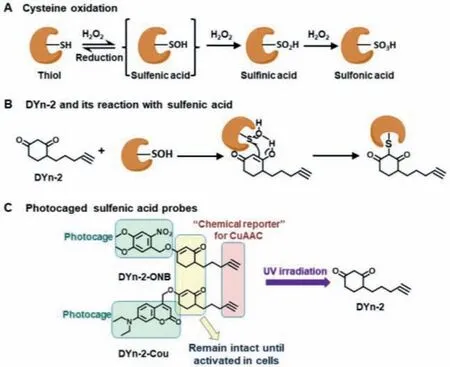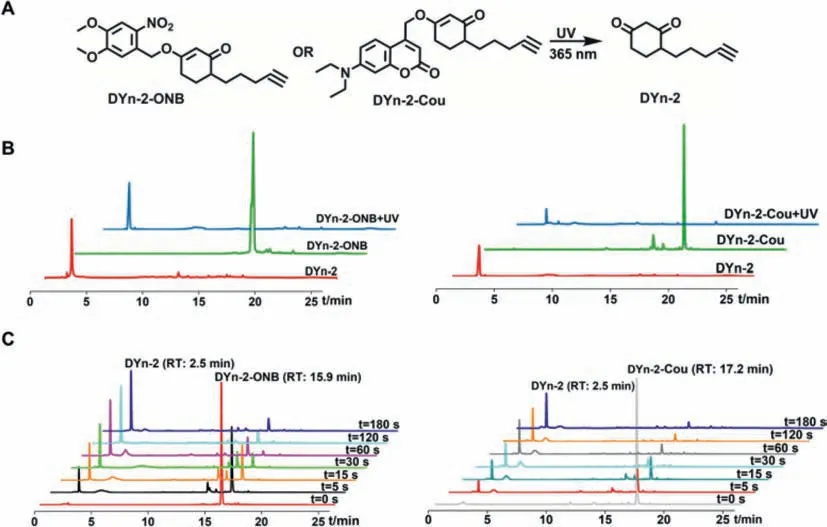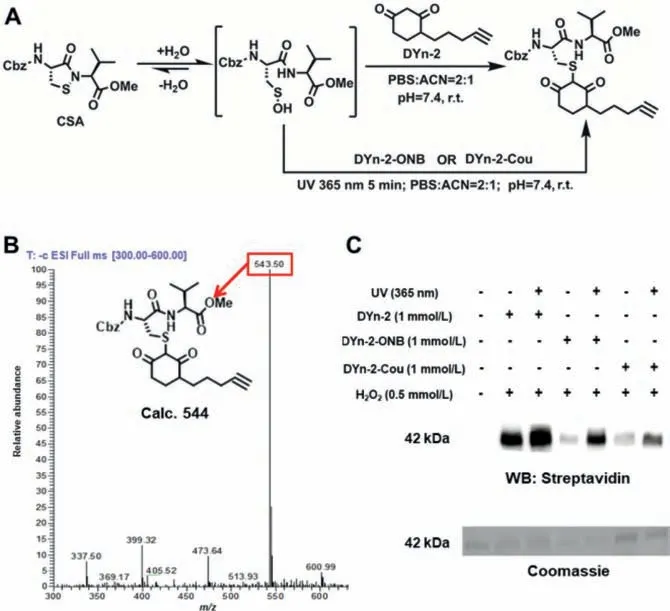Photocaged activity-based probes for improved monitoring of protein S-sulfenylation in living cells
Jiahao Zhang ,Haiyue Peng ,Zi’an Chen,Guorui Li ,Jing Huang
State Key Laboratory of Chemo/Biosensing and Chemometrics,Hunan Provincial Key Laboratory of Animal Models and Molecular Medicine,School of Biomedical Sciences,Hunan University,Changsha 410082,China
Keywords: Cysteine Sulfenic acid Activity-based probe Photocage Light activation Protein S-sulfenylation
ABSTRACT Protein S-sulfenylation (protein sulfenic acid),as one of the most significant oxidative post-translational modifications (OxiPTMs),plays a vital role in regulating protein function.A variety of activity-based probes have been developed to profile sulfenic acid in living cells.However,due to the transient presence and low content of sulfenic acid in living cell,high doses of probes are needed to achieve efficient labeling.More importantly,current probes have no temporal control over sulfenic acid labeling.To overcome these limitations,two caged cysteine sulfenic acid probes DYn-2-ONB and DYn-2-Cou with either an o-nitrobenzyl or coumarin protecting group were developed in this study.Both probes can be effi-ciently uncaged via irradiation to produce the active C-nucleophile probe DYn-2.Labeling assay in living cells demonstrated DYn-2-ONB exhibited better labeling capacity compared with DYn-2,providing it as a powerful tool for improved monitoring of protein S-sulfenylation in living cells.
Cysteine residues play a vital role in maintaining the function of many proteins since they are catalytic residues for many enzymes including transferase (desulfurase) [1],hydrolase (cysteine protease) [2],and isomerase (protein disulfide isomerase) [3].Cysteine can undergo oxidative post-translational modifications (OxiPTMs) by reactive oxygen species (ROS) and these processes have been implicated in many cellular processes [4],including signal transduction [5],autophagy [6],and differentiation [7].
Cysteine can be oxidized to different oxidation states.As shown in Fig.1A,the thiol group (-SH) of cysteine can be first oxidized to sulfenic acid (-SOH).Sulfenic acid can be further oxidized to sulfinic acid (-SO2H) and sulfonic acid (-SO3H).Among these oxidation states,sulfenic acid attracts much attention due to its reversible property,which is proved to be involved in redox regulatory mechanisms and signaling pathways.Sulfenic acid is also a biomarker of cellular oxidative stress [8].However,sulfenic acid detection is a big challenge due to its low content,high electrophilicity and rapid turnover in cells.Moreover,it is an intermediate state,and difficult to capture [9].Initially proteinSsulfenylation was detected by an indirect approach which involved pre-blocking of cysteine,reduction of Cys-SOH and then labeling of nascent thiols with cysteine probes [10].This approach has some limitations such as extensive denaturing conditions and unmanageable reduction steps.To address these issues,different probes which directly trapped Cys-SOH were developed.Dimedone is a classical Cys-SOH probe [11].Based on this scaffold,Carroll group has generated a variety of C-nucleophile probes to achieve better reactivity and selectivity [8,12,13].These probes can be also attached with an alkyne or azide group,so the labelled proteins can be easily detectedviaCuI-catalyzed azide-alkyne click reaction(CuAAC) [14,15].As shown in Fig.1B,DYn-2 is a widely used Cys-SOH probe in recent years,which has been successfully applied for monitoring changes of protein sulfenylation during cell signaling [16] and other cell processes.Besides dimedone-based probes,some other effective trapping reagents including strained alkynes[17] and alkenes [18-20] have also been applied for Cys-SOH detection.In addition,fluorogenic probes have drawn much attention due to their ability to monitor various substances in living cells and even in animal models [21-23].Recently,Carroll group reported fluorogenic probes for detecting protein sulfenic acid in living cell [24].

Fig.1.(A) Different oxidation states of cysteine.(B) The chemical structure of the widely used sulfenic acid probe DYn-2 and its reaction mechanism for capturing sulfenic acid.(C) This work: Photocaged activity-based probes for detection of sulfenic acid.
So far,a variety of Cys-SOH probes have been discovered and some of them including DYn-2 have been successfully exploited for profiling proteinS-sulfenylation in live cells.However,there are still some limitations for these probes.First,protein sulfenic acid are highly transient and labile,thus anin-situactivation of caged probes would be advantageous for its capture.We envision photochemistry might be a good strategy to address this issue in view of its spatiotemporal controllability [25-27].Photocage groups have been widely used in various fields,and photocaged probes derived from these groups have been applied to a variety of applications [28,29].Second,sulfenic acid is short-lived and it’s easy to be affected by the local microenvironment in live cell [30],thus high concentrations of these probes (e.g.,1 mmol/L or even 5 mmol/L DYn-2) were usually required for successful labeling in living cells.Although some probes have shown good selectivity towards sulfenic acid over other reactants in cell-free experiments,they might not behave the same in cells considering the complexity of cellular context.Thus,a large quantity of these probes might be consumed before they reached the targets.This may account for high doses of these probes for efficient labeling of sulfenic acid in cells.Taken together,photocaged probes may provide a good strategy to monitor the dynamic change of protein sulfenic acid in living cells.
To this end,here we developed photocaged probes forinsitudetection of sulfenic acid in living cells.The similar approach has been applied for cysteine reactivity analysis in cells by Weerapana group previously [31,32].The carbonyl group in these cysteine probes can be easily modified to form protected ketal,thus abolishing their reactivity towards thiols [32-34].Inspired by these findings,we introduced photoremovable protecting groups (PPGs)to DYn-2 to obtain caged Cys-SOH probes.Among a variety of PPGs [35],o-nitrobenzyl (ONB) and coumarin (Cou) derivatives are two of the most widely used due to their easy modification and removal.So,we chose them to prove our concept (Fig.1C).As shown in Scheme 1,both PPGs can be easily attached to DYn-2 by one step ketalization reaction to obtain the desired probes DYn-2-ONB and DYn-2-Cou.The PPG1 (4,5-dimethoxy-2-nitrophenyl)methanol is commercially available and PPG2 7-diethylamino-4-(hydroxymethyl)-coumarin can be easily synthesized by two steps using 7-diethylamino-4-methylcoumarin as the starting material(Scheme S1 in Supporting information).The detailed synthetic information and characterization data (including1H NMR,13C NMR and HRMS) of these compounds were given in Supporting information.

Scheme 1.Synthetic routes for the caged probes DYn-2-ONB (A) and DYn-2-Cou(B).
With the probes in hand,we first tested their uncaging process by HPLC analysisviairradiation with an ultraviolet (UV) lamp(365 nm,10 W).We anticipated the protecting groups can be removed by UV irradiation to provide DYn-2 (Fig.2A).As shown in Fig.2B,DYn-2-ONB had a peak at retention time (RT) of 15.9 min,and DYn-2-Cou gave a peak at RT 17.2 min.Upon irradiation for 5 min,the peaks for these two probes disappeared and a major peak with RT 2.5 min which was consistent with that of DYn-2.Then we monitored the conversion by irradiation with different time.As shown in Fig.2C,the proto-cleaving processes for both probes were irradiation-time dependent.For the probe DYn-2-ONB,the deprotection efficiency reached up to 90% after 3 min UV irradiation.Compared with DYn-2-ONB,the probe DYn-2-Cou was more photolabile.More than 90% of DYn-2 was obtained from DYn-2-Cou within 1 min irradiation.It is worth noting that besides the remaining probe and produced DYn-2,some other peaks appeared with shorter irradiation time,which might indicate the intermediates [36-38],since eventually most of them were converted to DYn-2.

Fig.2.The uncaging process of the probes by irradiation under 365 nm.(A) Schematic illustration of the uncaging process.(B) HPLC analysis of the uncaging process.(C)Time-dependent uncaging process measured by HPLC.
Having established that the caged Cys-SOH probes can be efficiently uncaged by irradiation to produce the active DYn-2,we then asked whether they can be used for sulfenic acid capture.Considering the instability property of Cys-SOH,a good model would facilitate the reactivity study [39].Recently Carroll group discovered dipeptide cyclic sulfenamide (CSA) as a sulfenic acid model [8].CSA can be readily transformed to transient sulfenic acidinsituin aqueous solution.DYn-2 has previously been reported to react with sulfenic acid on dipeptide cyclic sulfenamide(CSA) [8].Here we also used CSA to test the reactivity of our probes (Fig.3A).We first tested the reaction of DYn-2 with CSA using ESI-MS.Incubation of DYn-2 with CSA (in mixed solution,v/v,PBS buffer:ACN=2:1,pH 7.4) at r.t.for 30 min can give a major peak withm/z544,which was consistent with that of the desired adduct (Fig.3A and Fig.S1 in Supporting information).We then treated the caged probes with CSA under the same condition by 5 min UV irradiation (365 nm,10 W).As expected,we obtained the desired adduct for both probes (Fig.3B and Fig.S2 in Supporting information).

Fig.3.Detection of the ability of probes to capture sulfenic acid by using a small molecule model CSA and a model protein USP2CD.(A) Reaction routes of CSA with DYn-2,DYn-2-ONB and DYn-2-Cou.(B) Incubation of DYn-2-ONB with CSA (in mixture solution,v/v,PBS buffer:CAN=2:1,pH 7.4) at r.t.for 0.5 h after 5 min UV(365 nm,10 W) irradiation,the sample was analyzed by ESI-MS.(C) Detection of the ability of probes to capture sulfenic acid using USP2CD as a model protein.Samples were analyzed by Western blot.
The above results proved the reaction of our probes with a cysteine sulfenic acid.We then asked whether these probes can label Cys-SOH in purified protein.Here,USP2CD was used as a model protein to test their reaction.USP2 is a human deubiquitinase (DUB),which can remove ubiquitin from its substrate.Previous reports have shown that the function of USP2 can be regulated by ROS,viathe formation of sulfenic acid of its active-site cysteine [40,41].We purified USP2CD,the catalytic domain of USP2(amino acids 259-605,42 kDa).USP2CD was first treated with or without DYn-2 in the presence of 0.5 mmol/L H2O2.Then after CuIcatalyzed azide-alkyne click reaction (CuAAC),the formed adduct was analyzed by western blot against streptavidin-HRP.As shown in Fig.3C,compared with no probe treatment,DYn-2 formed adduct at 42 kDa (compare lane 1 and 2).The caged probes and DYn-2 were irradiated by UV 365 nm for 3 min before CuAAC.The adducts were obviously observed for both caged probes with irradiation (Fig.3C,lane 5 and 7).Significantly,without irradiation,the adducts for both caged probes were not obvious (Fig.3C,lane 4 and 6),proving it was successfully caged.UV irradiation can induce the production of sulfenic acid to some extent (Fig.3C,lane 2 and 3),so care must be taken to handle these photocaged probes to minimize the irradiation time while ensuring activation.Coomassie blue staining showed that similar amounts of samples were used for all the conditions.
Taken together,all the above data have demonstrated our probes can react with sulfenic acid either on a small molecule model or on a purified protein system.We next tested whether our probes can label protein-SOH in cell lysate or living cells.As shown in Fig.4A,cell lysate was treated with H2O2(0.5 mmol/L) at r.t.for 20 min.After addition of probes (1 mmol/L),the mixtures were irradiated for 3 min.The azide tag was attached by CuAAC after a further incubation for 1 h,followed by western blot analysis.Compared with the control (lane 1),all probes gave labeling bands (Fig.4B,lane 2,5 and 7).Significantly,both caged probes did not give obvious labeling bands without UV irradiation (Fig.4B,lane 4 and 6).Similar to the USP2CD sulfenic acid labeling,UV treatment can slightly induce the production of sulfenic acid (Fig.4B,lane 2 and 3).Coomassie blue staining for the same samples indicated same amounts of proteins were loaded (Fig.S3 in Supporting information).Finally,proteinS-sulfenylation was profiled by these probes in live cells.HeLa cells were incubated with 0.5 mmol/L H2O2for 30 min,then different probes were added and incubated for 2 h.Next,after UV irradiation for 3 min,HeLa cells were incubated in fresh medium for 30 min.Then cells were lysed and the following procedure was same as the above.The labeling results in living cells were shown in Fig.4C.Compared with cell lysate labeling by DYn-2,much less bands were observed in the living cell labeling.UV irradiation had less effect on sulfenic acid in living cells compared to USP2CD and cell lysates,possibly due to the complex environment in living cells,which may have mitigated the effect of UV exposure.Distinctly,DYn-2-ONB still exhibited strong labeling efficiency,proving it had better labeling capacity in living cells than DYn-2.Compared with that,fewer bands were observed in DYn-2-Cou treated cells.Poor solubility of DYn-2-Cou can be one reason.Actually,some precipitation was observed when DYn-2-Cou was added into the medium.Phototoxicity might be another reason for its low labeling ability in living cells,since multiple studies have shown coumarin-containing reagents are toxic under irradiation [42,43].Then we evaluated cell viability with MTT assay.The results showed that UV irradiation for 3 min had little effect on the cell viability (94% viability).DYn-2-ONB showed modest phototoxicity (53% viability) in the presence of 1 mmol/L DYn-2-ONB,0.5 mmol/L H2O2and UV irradiation.As a comparison,DYn-2-Cou was more toxic than DYn-2-ONB.Only~36% of cells were alive under the same treatment (Fig.S4 in Supporting information).Since DYn-2-Cou is fluorescent,we also investigated its distribution in cells by confocal microscopy.Similar to the recently reported fluorogenic probes [24],DYn-2-Cou was widely distributed in the cytoplasm with no obvious subcellular organelle localization (Fig.S5 in Supporting information).

Fig.4.(A) Schematic diagram of the operation flow of in vitro and in vivo experiments.(B) Comparison of the ability of DYn-2,DYn-2-ONB and DYn-2-Cou to label sulfenic acid in cell lysate.(C) Comparison of the ability of DYn-2,DYn-2-ONB and DYn-2-Cou to label sulfenic acid in living cell.
Collectively,all the data have proved DYn-2-ONB exhibited potent ability to capture protein-SOH in living cells,which was worthy of further investigation.Therefore,we carried out experiments with DYn-2-ONB of different concentrations.As shown in Fig.S6 (Supporting information),the ability of DYn-2-ONB to capture sulfenic acid was concentration-dependent.It is worth noting that without UV irradiation,no labeling bands were observed in the presence of DYn-2-ONB.This result clearly substantiates our notion that the caged probe is not active in living cells,until it was activated by irradiation.
In conclusion,we developed two caged Cys-SOH probes DYn-2-ONB and DYn-2-Cou for theinsitudetection of proteinSsulfenylation.The extracellular systems proved both probes can efficiently capture sulfenic acid either with a small-molecule model(CSA) or with a purified protein model (UPS2CD).However,they exhibited distinct labeling property in living cells.The caged probe DYn-2-ONB showed better labeling capacity than the widely used probe DYn-2,while DYn-2-Cou labeled fewer protein-SOH,partly due to its poor solubility and its high phototoxicity towards cells.DYn-2-ONB can capture sulfenic acid in cells in a temporally controllable way,which implies that the change of sulfenic acid in cells may be monitored.The good performance of DYn-2-ONB,together with its temporal control over sulfenic acid,provides it as a powerful tool for the study of biological role of cysteine oxidation in living cells.The different labeling styles between DYn-2-ONB and the conventional probe DYn-2 also intrigue us to compare their application in Cys-SOH proteomics and this work is ongoing in our lab.
Declaration of competing interest
The authors declare no competing financial interest or personal relationships that could have appeared to influence the work reported in this paper.
Acknowledgments
This work was supported by the National Natural Science Foundation of China (Nos.31871365 and 22177029) and Fundamental Research Funds for the Central Universities.
Supplementary materials
Supplementary material associated with this article can be found,in the online version,at doi:10.1016/j.cclet.2023.108560.
 Chinese Chemical Letters2024年2期
Chinese Chemical Letters2024年2期
- Chinese Chemical Letters的其它文章
- The 3rd Xihua Chemistry and Biomedicine Forum
- Professor Hualiang Jiang: A tribute to an esteemed visionary chemist and pharmacist
- Recent advances in visible light-mediated chemical transformations of enaminones
- Development of porphyrin-based fluorescent sensors and sensor arrays for saccharide recognition
- Recent advances of versatile reagents as controllable building blocks in organic synthesis
- Synthetic host-guest pairs as novel bioorthogonal tools for pre-targeting☆
